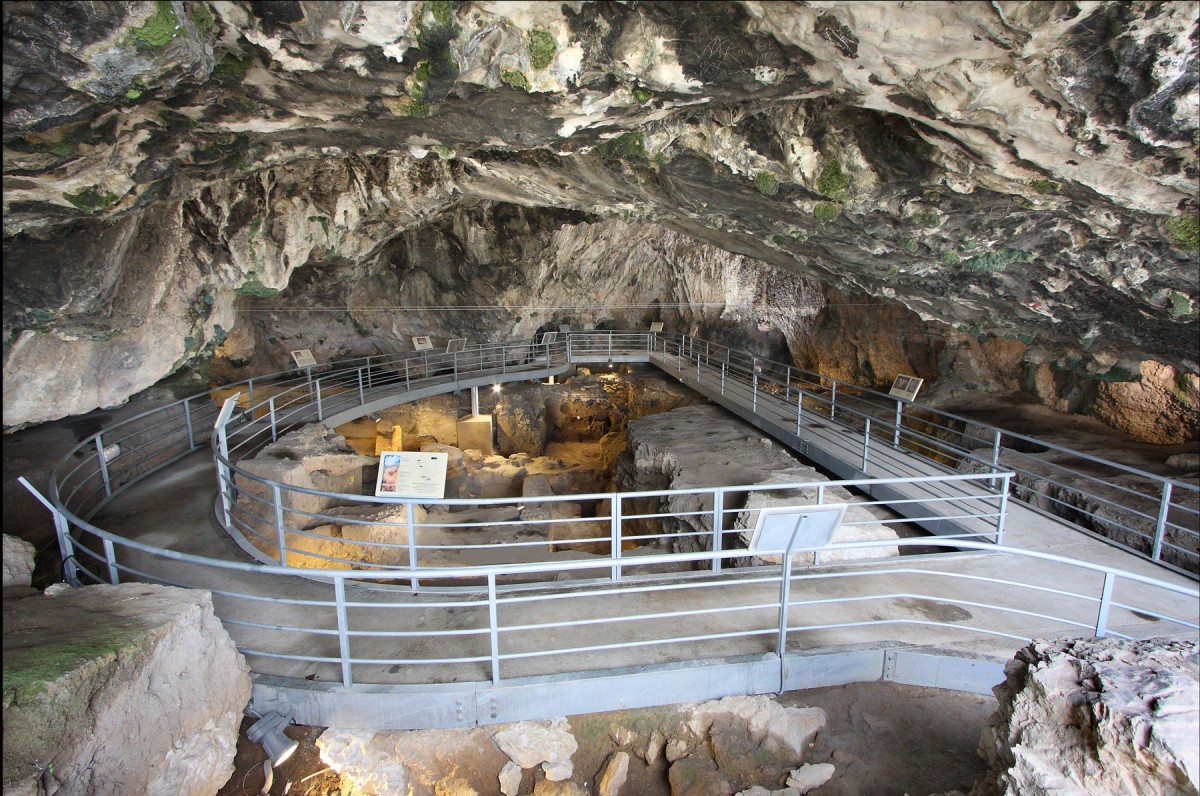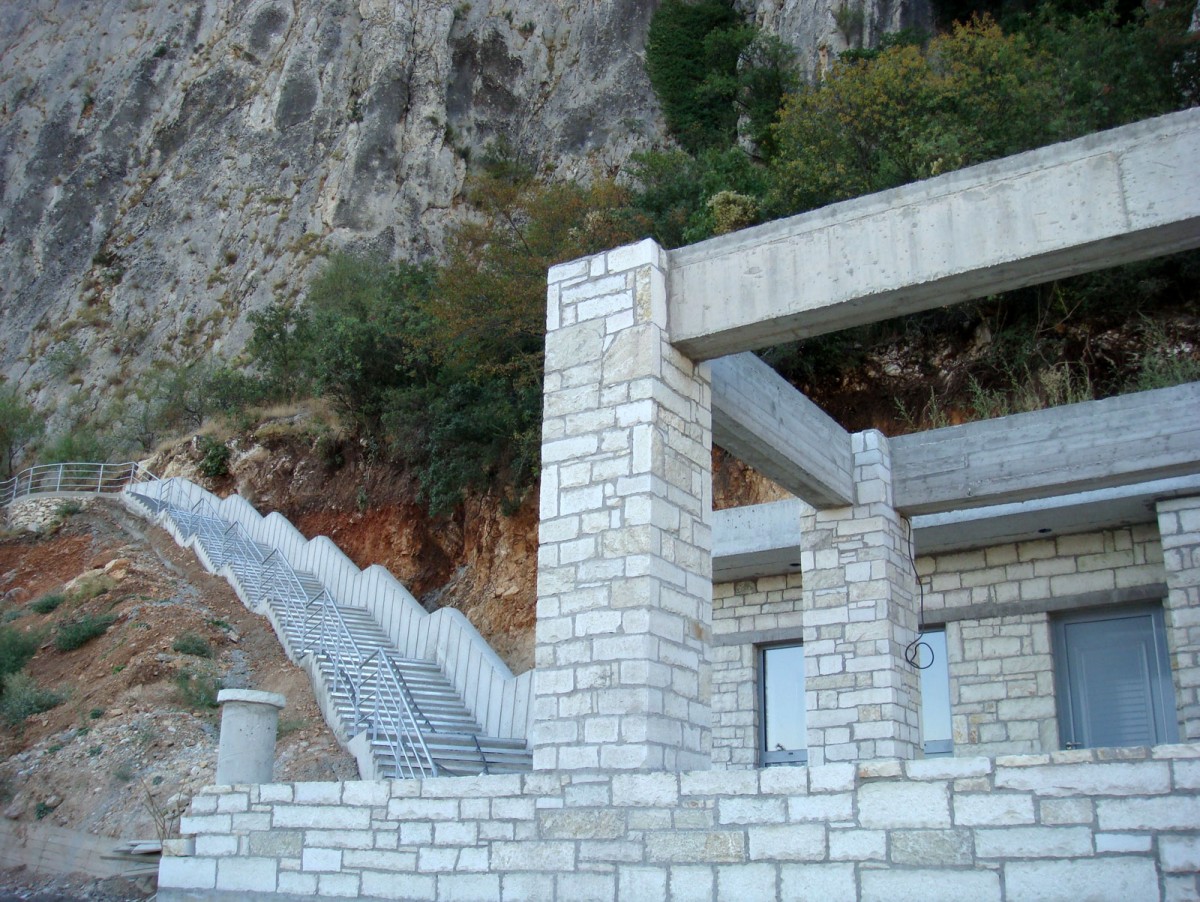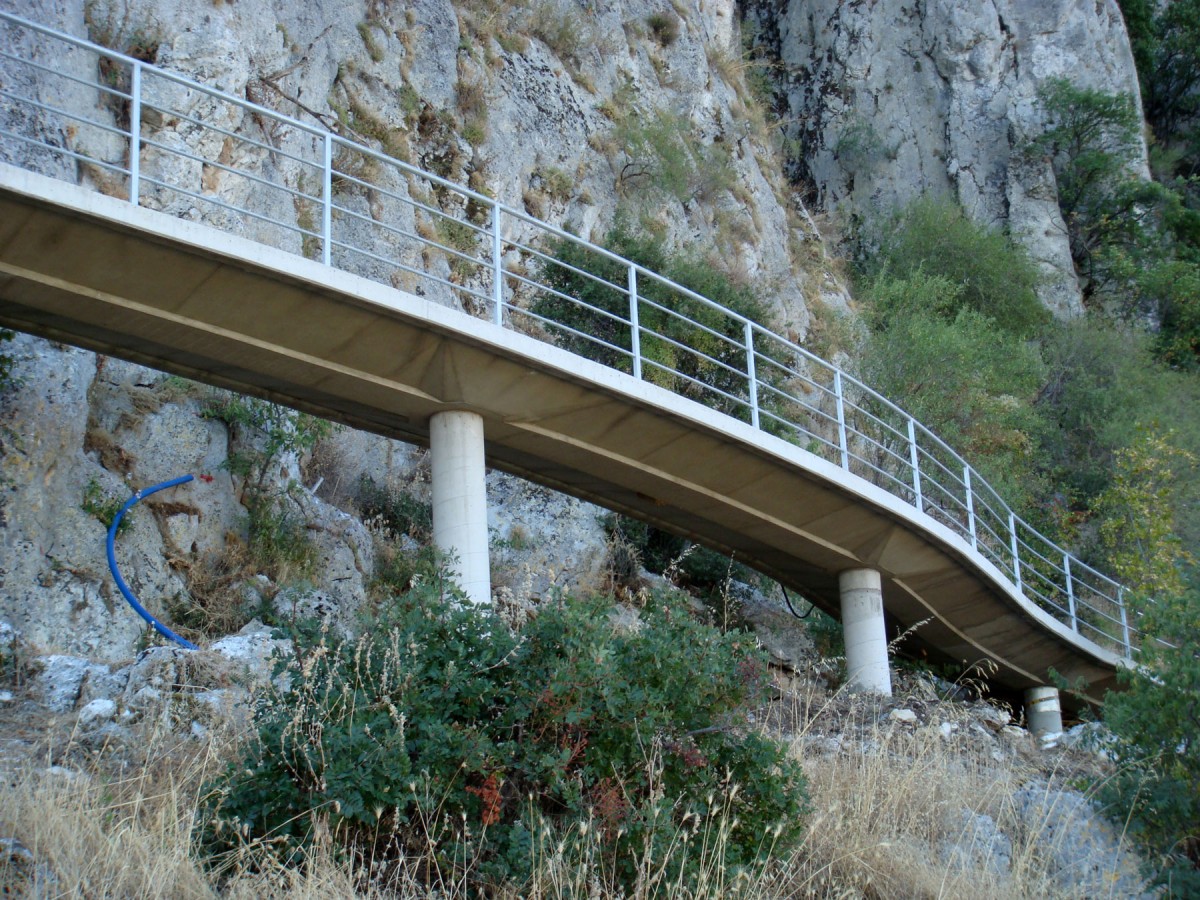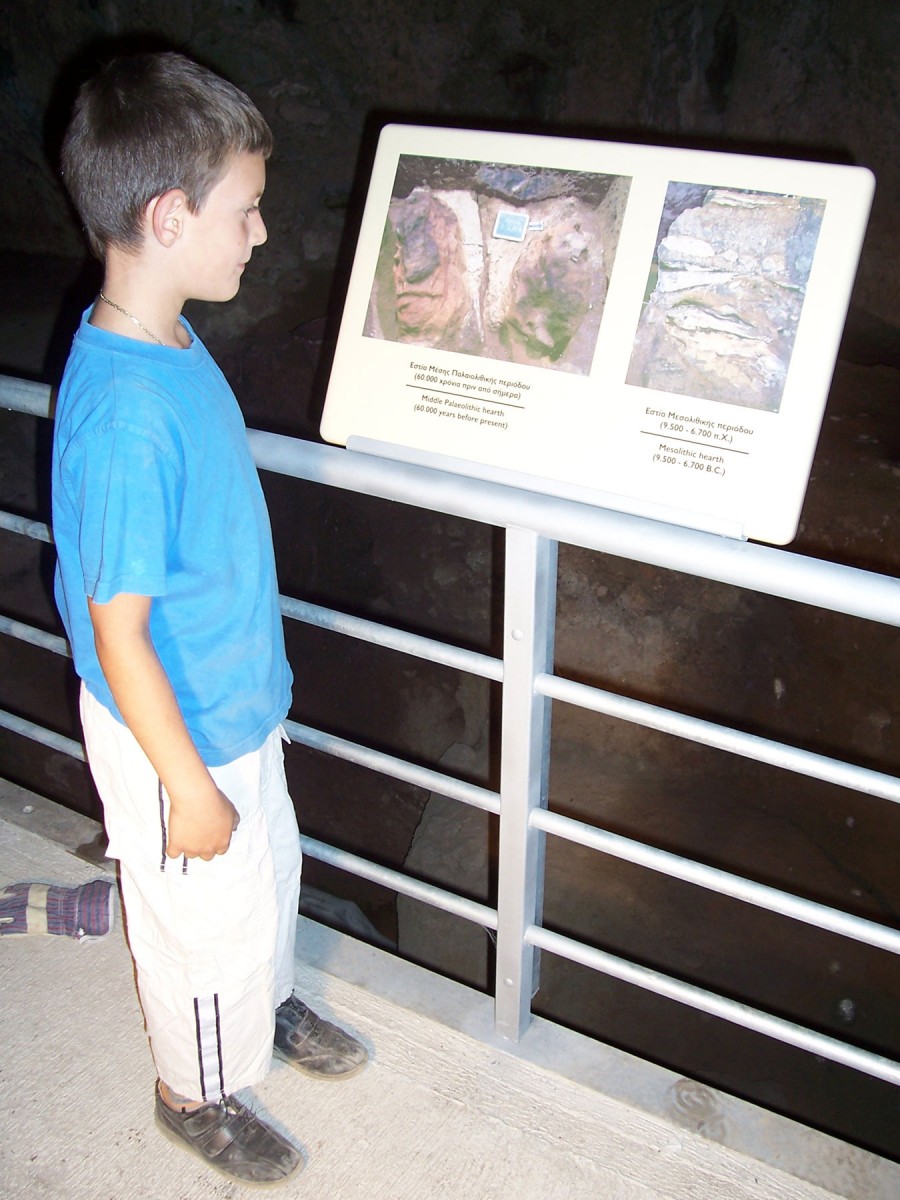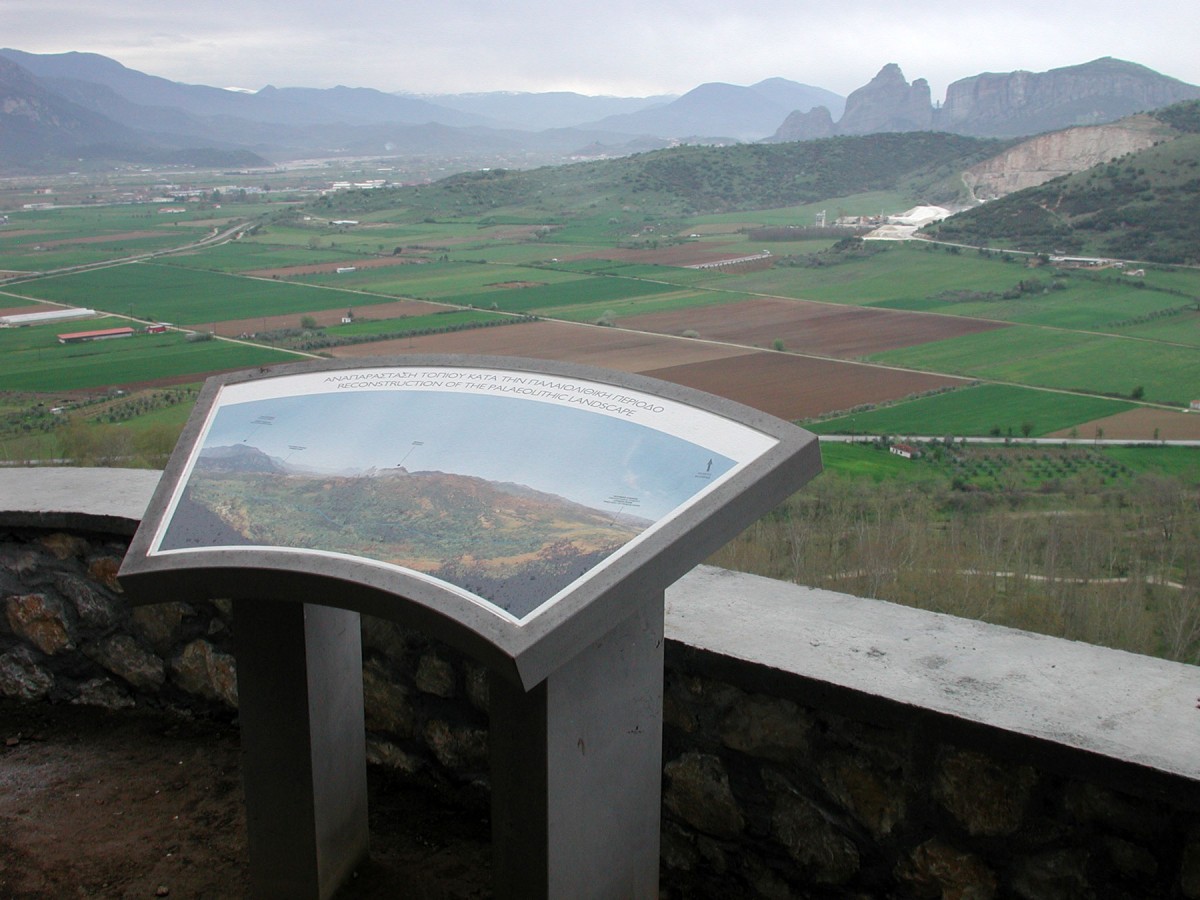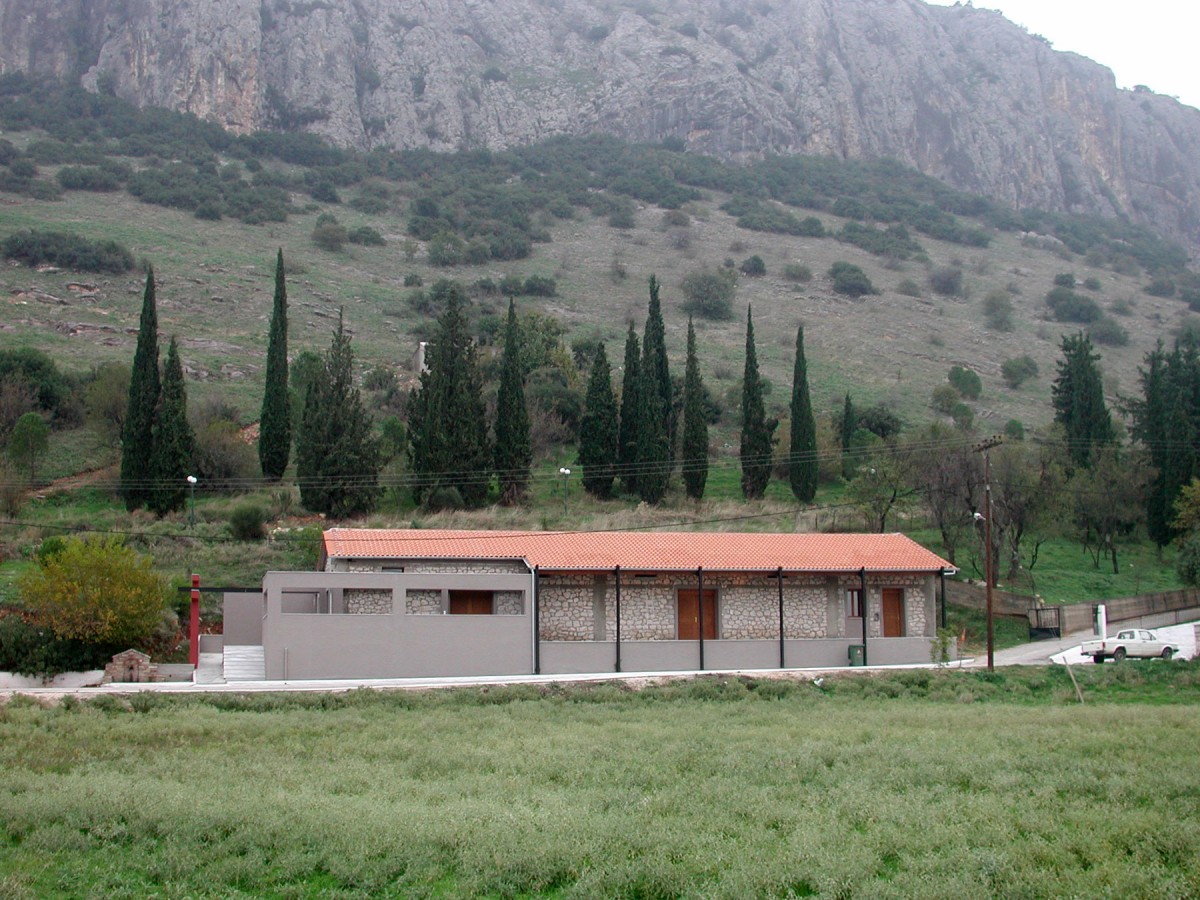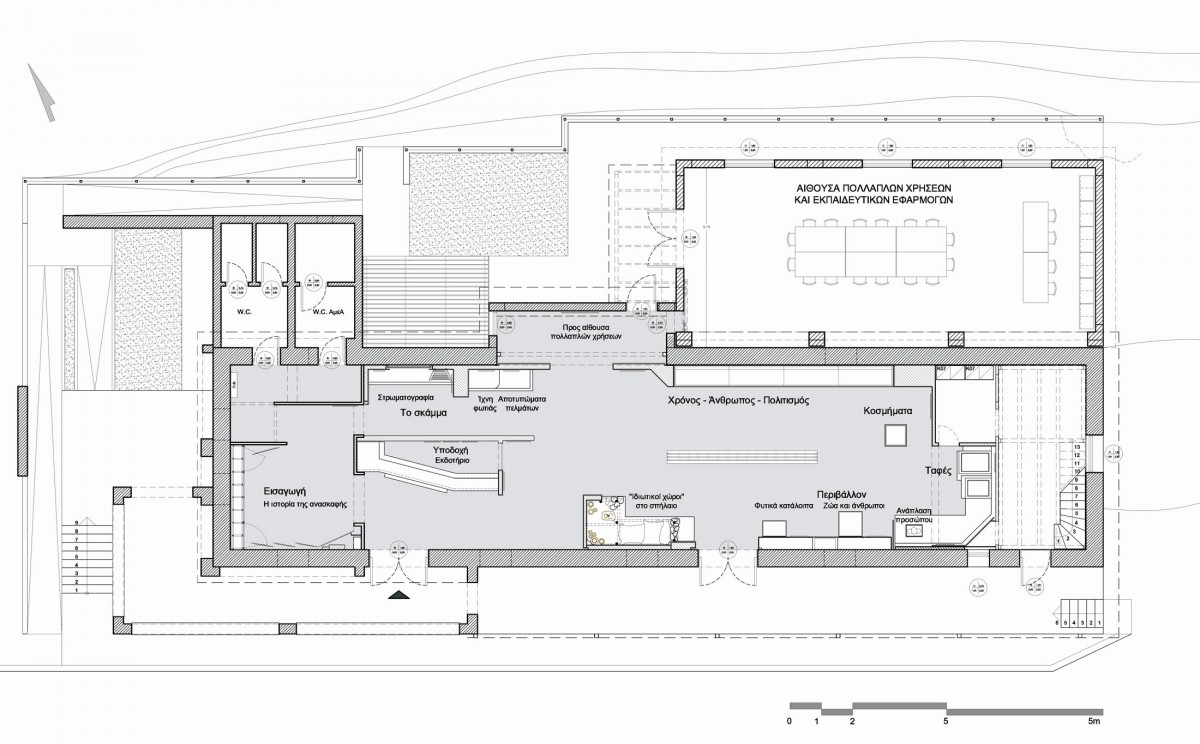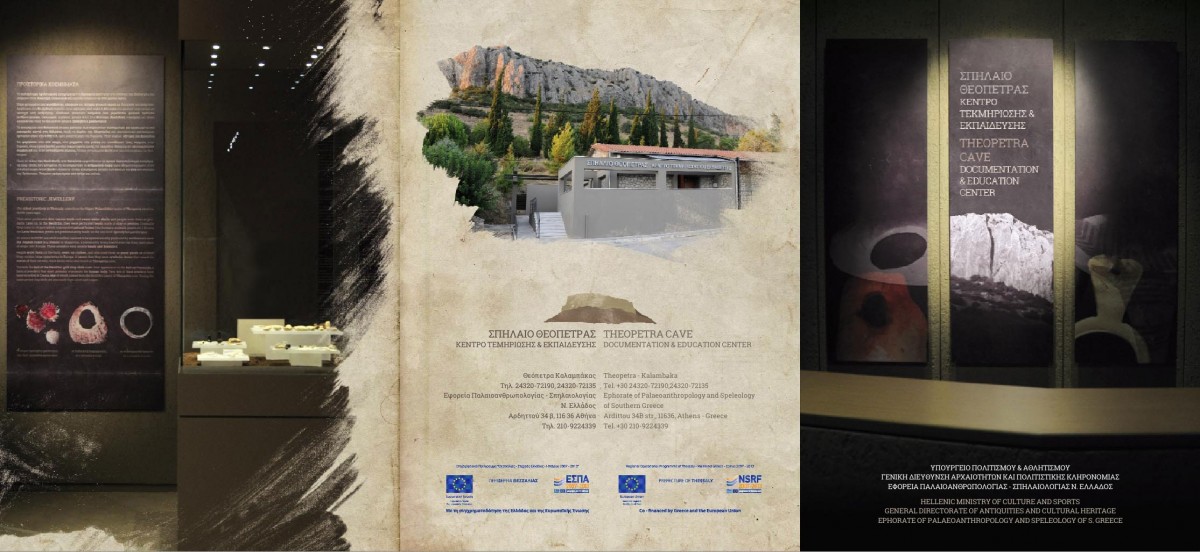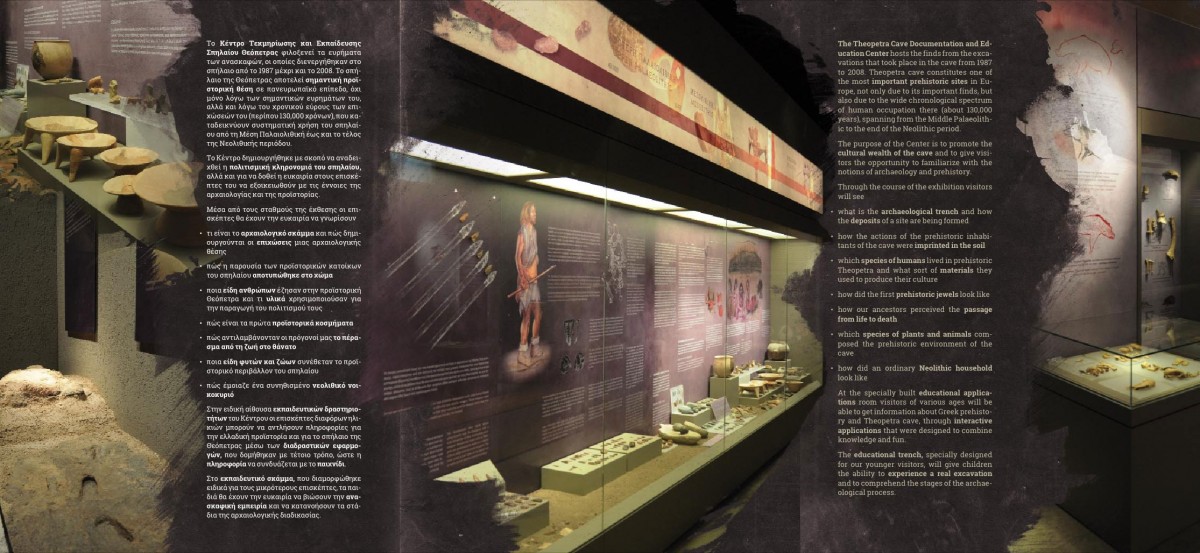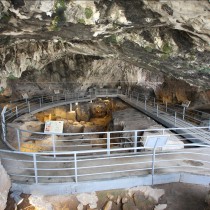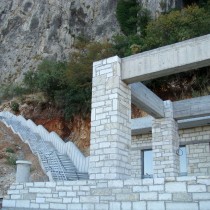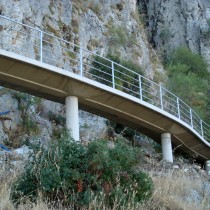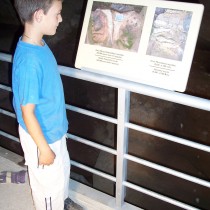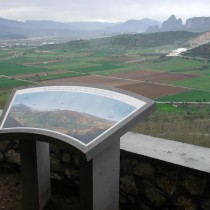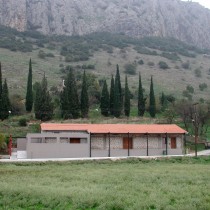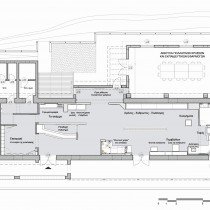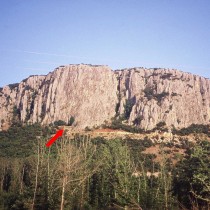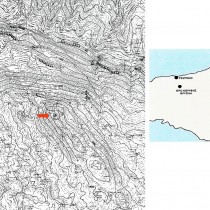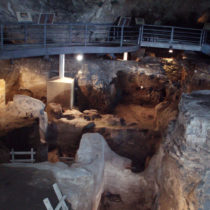To date, the biggest and the most complete research programme of the Ephorate of Palaeoanthropology and Speleology (EPSSG) is that of the Theopetra cave. The facts presented in the 1st and 2nd part of the special issue reveal the reasons for which the cave became an object for enhancement through community programmes of the 3rdCommunity Support Framework (CSF). Its enhancement presented us with a dilemma, knowing that this entailed burdening the archaeological site with the required technical works. On the other hand, we believed that the people of Thessaly as well as foreign visitors to close by Meteora, should be able to visit this site that had been a cradle of our civilization (fig. 1). Outside the cave, therefore, access was made possible for everyone, even those with problems of mobility (figs. 2-3), while inside, visitors can walk across on a metal passageway above the excavation trenches, looking down on the remains preserved in situ; hearths from different periods, climate changes as reflected in the stratigraphy, the human foot prints, the burial spots, one of which is being exhibited et al.). Moreover, posted signs give more information about the finds (figs. 4-5) and special discreet lighting enhances the cave’s natural environment. Thus the works for enhancing the cave and its excavations finally proved to be a proper choice, since they managed both to keep the cave’s atmosphere almost as intact as it had been when we first started exploring and the excavation itself to be seen, depending on the finds, at the various stages at which it had stopped. Besides, the constant increase in numbers of visitors supports this choice of enhancing the cave.
Creating the Museum
As these lines are being written, we have the pleasure of seeing the museum completed, exclusively dedicated to the excavation finds and officially called The Centre of Documentation and Training of the Theopetra Cave, following the relevant official opinion of the council of museums and a similar Ministerial decree (ΥΠΠΟ/ΓΔΑΠΚ/ΔΜΕΕΠ/Γ1/Φ21-ΕΠΣΝΕ/59037/1004/1.9.2009 &18.9.2009). We have always been convinced that a place offering such important facts about man’s evolution in Greece, has the right to its own museum space. Aside from our own effort and proposal, the museum’s founding was made possible thanks to the Community of Theopetra and the Municipality of Vassiliki granting us the building space at the time, but also thanks to the first rate collaboration with Mr Vaios Ziakas, the mayor then in office (today it belongs to the extended Municipality of Kalambaka). A stone building already existed (fig. 6) with net dimensions on its inside of 188.21 sq.m. (gross: 229.05 sq.m.), originally belonging to the Agricultural Cooperation of Theopetra and already renovated to become a Folklore Museum through the Leader programme. The Municipal council accepted our proposal and granted us the building to create a museum for the finds of the cave, recognizing their value regarding the place, its history and the development of the small village that is actually very close to Meteora, the well known destination of many visitors.
The areas in the renovated existing building had already been upgraded according to modern standards and included facilities for the access to the museum of people with disabilities. Following a study, an extra 82 sq.m. space was added on the back NE side in proportion with the pre-existing corresponding section of the NW side, so as not to spoil the building’s original form (fig. 7). The new space has been designed to run educational programmes, mainly for pupils and students, but also for groups of adults if they request them.
The exhibition (figs. 8-9)
The idea of the exhibition is based on promoting the evolution of Prehistoric man in the region of Thessaly, from the Palaeolithic period to the interim of the Mesolithic up to and including the Neolithic period. For many decades now, the latter is well known in bibliography, whereas the Palaeolithic and Mesolithic periods, which date to almost 130,000 years ago up to approximately 6700 BC, were located for the first time in the Theopetra cave in Thessaly.
The presence and evolution of man is promoted in The Centre of Documentation and Training of the Theopetra Cave in the following manner (fig. 7):
In a small hall, to the left of the entrance, photographs and information have been posted about the history of the excavation, the first handwritten records of the material, later replaced by digital ones, a catalogue of publications etc. Also mentioned are all the names of the colleagues and scholars of the excavation. On the west wall of the same area, a metal storage space has been installed with its contents accessible, archaeological material (mainly heavy stone tools, ceramics, bones etc.) stored in crates, as well as samples of tools and other equipment used in the excavation.
The archaeological exhibition itself starts with an exact copy of the stratigraphic cross section, almost 3.50 m above the cave’s excavation, created by P. Polydoropoulos and Y. Gioni, conservators of the Ephorate of Palaeoanthropology and Speleology, with the collaboration of the archaeologist O. Apostolikas, and posted on the wall at the front (west part of the north wall) of the building’s main hall. On it appear all the chronological phases contained in the embankments, starting from the Neolithic period and ending in the deepest Palaeolithic layers. The changes in climate can be distinguished, as well as a one of the 60,000 year old hearths, the thick sediment that filled the cave after intense flooding, the deepest layer with the 130,000 years old remains of a fire et al.
After the stratigraphy, some indicative exhibits can be seen; a) A hearth from the Palaeolithic period, one of many (at least 15) dated 60,000 years old and reflecting a phase of improved climate during the Ice Age, b) A reproduction of the surface with the four human footprints found on a burnt surface of sediment dated 130,000 years old and which constitute a very rare find worldwide.
Next, on the same long north side of the building, in special sections chronologically divided (Middle Palaeolithic, Upper Mesolithic and Neolithic), man’s evolution in stone technology and his activities are exhibited in a large show case. They begin with raw materials and early tools dated 130,000 years old or more, continuing with tools in specific technological categories, intended for specific uses such as hunting, the skinning of animals etc depending on the period of civilization and the climate that influenced the fauna, hunting etc reaching the Neolithic period with tools used for cultivation, harvesting crops, felling trees et al. This presentation is supplemented at the “back” of the exhibition surface by visual material, original paintings by Dimitra Bakoyiannaki, employee at the EPSSG and graduate of the Athens School of Fine Art. Depending on the period, these depict either the treatment of stone or its specific uses, as well as hunting scenes and the “social” life of the cave dwellers (see indicatively figs. 8-9), the production of ceramics in the Neolithic section etc. Also shown in the section on the Mesolithic period is the evolution of the use of clay, initially in its unbaked form, that ultimately led to the ceramic technology of the Neolithic period. In the latter section, there is information on the next stage of this knowledge of ceramic technology with representative samples of ceramic finds from the cave. The Neolithic section, especially, is enriched by other objects such as equipment for weaving (whorls, loom weights), polished stone tools, bone tools and figurines.
The jewellery is exhibited in a special showcase; the first pieces are Palaeolithic deer teeth and a fresh water shell from the nearby river, all pierced to be worn as pendants for self adornment, next are beads made of a variety of materials (stone, shells, bone, boars’ tusks), of all sizes and types from all the sub periods of the Neolithic age, as well as jewellery that imitate natural prototypes (anthropomorphic, zoomorphic et al.). Finally there are big beads made of the sea shell Spondylus Gaederopus, that appear to have been imported from the Balkans, as well as bracelets made of the same material which perhaps were the first objects of European trade from the Aegean towards central Europe. The prize of this showcase is a gold ring shaped piece of jewellery, that dates perhaps to 4000 BC and is one of just a handful, also native to the Balkans, found in Greece.
At the end of these sections, on the east side of the hall, in an artificial hollow designed to resemble a dark cave, two human burials of the Palaeolithic and Mesolithic period, dating to 14500 and 7000 BC respectively, have been placed in the way they were found inside the cave. They are accompanied by related texts with information concerning their palaeopathology, their way of life revealed from their diet, as seen in special tests carried out. These texts also refer to DNA tests that prove the gene continuity of the Palaeolithic and Mesolithic populations, proving, in turn, that these had evolved indigenously in the same place, thus raising doubts about an earlier theory on the Greek Neolithic population and its civilization originating from the Middle East. Information is also given on burial practices during prehistory.
Moreover, it has been proposed that this section exhibit a representation of the features of one of the found Mesolithic skulls, specially made in laboratories abroad, for it to be better understood by visitors. (So far, although it has started to be made, it could not, unfortunately, be delivered on schedule and its display is pending.) In its place, for the time being, a skull from the Upper Palaeolithic period is being exhibited.
Leaving, at this point, the east area with the burials, there is another section, on the building’s long side, dedicated to the flora and fauna of the cave from different chronological periods (see indicatively fig. 9); bones found in the excavation, animal species, both the wild ones of the Palaeolithic period as well as those domesticated much later in the Neolithic era. Visual material is at the back of the section or next to the bones, the animal species being depicted either in photographs or in representations of rock paintings from various caves in Europe or schematically.
Next, in another showcase on the same south side, plant seeds are exhibited, wild during the Palaeolithic period and cultivated during the Neolithic, from which there is also proof of the continuity of man’s knowledge regarding the properties of plants. This led gradually to their cultivation in the Neolithic period and is one more factor proving an indigenous development of cultivation in the same place. This show case is supported by a wealth of visual material with types of plant in today’s survival of the species, while information is given about the evolution in the use of plants; initially wild species collected by hunter gatherers and then cultivated, as a development of the observations made by those same people and their off spring.
At the end of this south side, an attempt was made to recreate a Neolithic household in a “hut”. This was based both on information resulting from the cave excavation, where lots of utensils have been found for various uses, as well as information from other Neolithic settlements in Thessaly. Specific finds in the cave, such as clay surfaces with imprints of reeds and wood or ruined bricks, point to the existence within it of “private” spaces for the protection of households, infants or the sick. The different distribution of ceramics within the cave also supports such a model (Katsarou, in the forthcoming volume on the Neolithic period).
The exhibition is completed by information boards posted in the reception area with the names of all the museum collaborators.
Educational programmes
As mentioned previously, at the beginning of the Museum section, an additional space of 82 sq.m. was created at the back NE part of the building, to be used for digital and educational programmes (a multipurpose Hall) addressing children at every level of education.
The educational applications, created in both Greek and English and supervised by the archaeologist Dr O. Apostolikas, were incorporated in two multi touch screens suspended in the multi purpose hall. There, visitors have access to texts with general information on prehistory and archaeology but also of a more specific nature concerning archaeological data of the Theopetra excavations. Based on facts from these texts, visitors can then explore the educational applications whose aim is to offer knowledge through play. Playing individually or in groups, visitors can test their knowledge in cross word puzzles of varying degrees of difficulty as well as in competitive quizzes. On the multi touch screen visitors can also see various photographs of the Theopetra finds, as well as the people contributing to the programme that is slightly under 30 years old. The educational applications are accompanied by a short documentary (approximately 15 minutes long) on the cave and its excavations. Having completed their “digital” acquaintance with Theopetra, the older pupils and students can have a discussion with their teachers and write about the issues raised, in a specially designed educational brochure distributed to them.
The multipurpose hall is equipped with a modern audiovisual and sound system so as to host other events besides educational activities, such as lectures or small scale temporary exhibitions.
Finally, in the courtyard at the back of the building, a virtual excavation with finds from the Theopetra cave has been created for the younger visitors. This aims to show the children the excavation process through play; in a square, demarcated trench measuring 5.00×3.30 metres and filled with sand and fine gravel, broken copies of pots and other small finds are buried and the children can explore the excavation process and have the satisfaction of discoveringfinds, lighting a fire etc. Outside the trench there is enough space for activities such as making stone tools with ancient methods, modelling clay,lighting a fire etc.
Contributions by colleagues – Acknowledgements
The following people contributed to the enhancement of the cave and to all of them I extend my warmest thanks for the design, supervision and application work. One sentence is not enough to include my real thanks both for the architecture itself and the subsequent designs either structural, electromechanical etc that were exactly in the spirit we wished to retain for the cave, and also for their application in the course of the technical and archaeological work. Architect Yiorgos Papadakis successfully realized the designs, often facing great difficulties related to the cave’s particular rocky environment both inside and out, as well as my own occasional anxiety as to whether we should have embarked on such large scale technical works Archaeologists Sophia Dafou and Orestis Apostolikas who supervised the excavation trenches that would help in installing the visitors’ passageway, worked in glacial conditions the first winter of 2005-2006 and with difficulties which subsequently emerged due to the work’s tight schedule. They themselves recorded and depicted the whole of the work’s excavation which in fact brought about especially interesting results that changed the data, established till then, in many spots. Craftsmen Yiannis and Nikos Bandekas, who had worked almost all those years on the same excavation that they loved, contributed in an invaluable way. Yiorgos Tziafetas, master craftsman, deserves special thanks for additionally making the work’s metal structure, which unfortunately was the last in his life. Conservators Panos Polydoropoulos and Yiota Gioni were responsible for very successfully fixing both the stratigraphy of the cross sections and the hearths and burials from various periods, for them to remain stable and visible in the cave. Graphic designer Anastasia Tzalla was responsible for the creation of the information boards and brochures accompanying the work, while their texts were written by archaeologist Orestis Apostolikas. Craftswoman Elena Kerasioti, under the name of “General Tasks” saw to all the invisible parts of the work. Finally, this writer was responsible for the project’s overall supervision, travelling 55 times between Athens and Theopetra for its duration and burdened with anxiety as to the outcome.
Project team: Efthymios Saliachis and Nikoletta Saliachi (architects), Spyros Fountis and Yiorgos Didaskalou (civil engineers), Vasileios Kakatsios( electrical engineer), Efi Karayianni (civil engineer from the Prefecture of Trikala, project supervisor).
The work of creating the Centre of Documentation and Training of the Theopetra Cave also resulted from the effort made by the members of the work team who in a coordinated way, despite many difficulties at times (financial and bureaucratic) succeeded in setting up an exhibition both original and “alive”, because it is interspersed with images of persons, giving it an everyday feeling understood, we believe, by all visitors.
I particularly want to thank architect-museologist Thomas Tsoukalas who immediately understood the spirit of the special museum space we wished to create and with whom we collaborated perfectly and productively during the work’s entire course. Equally, I must thank the following: Dr Orestis Apostolikas who implemented, in an inspired and creative manner, his expertise on the Upper Neolithic period and man’s evolution, Angeliki Kaznezi who, apart from her contribution in creating the Neolithic pottery section with Dr Stella Katsarou, also worthily took upon herself all the burden of the bureaucratic procedures taking place between the project, the Region of Thessaly and the Ministry of Culture. Dr Eleni Stravopodi created the successful assemblage of tombs with their corresponding texts, Dr Katerina Trandalidou, although not part of the excavation’s initial project team, became responsible for the composition of the show cases for the fauna from all the periods and I am grateful to her for that. She and Dr Georgia Kotzamani managed to “close” within a show case the history of the fauna and archaeobotanical remains respectively, making the maximum contribution by giving plentiful information in the spirit and atmosphere we had intended. Conservators Panos Polydoropoulos and Yiota Gioni as well as painter-graphic artist Dimitra Bakoyiannaki literally “did fine needlework”!
Yiannis Bandekas and Elena Kerasiotou were always there to support the work in every possible way. This writer, despite being pensioned off because of the economic crisis, struggled to realize the project designed by us and approved by the council of the Ministry responsible, which, along with the cave’s enhancement, completes the excavation works of Theopetra.
My colleague Dr Elena Panagopoulou, as successive head of the Ephorate of Palaeoanthropology-Speleology of Southern Greece (EPSSG) became responsible for the museum’s realization, which was not in her plans (just like other works of NSRF). I thank her warmly, because she took on the entire burden of administration and together we achieved a happy ending.
Warm thanks are also due once again to the Ministry of Culture, for supporting the cave’s enhancement as well as the creation of the museum. Both of these were special ventures and they succeeded also thanks to the support of the competent state body. These two works in particular also had the full support of the Administrative Authorities, both of the Ministry and of the Region of Thessaly. All of the above contributed, more or less, to the successful outcome and I thank them from the bottom of my heart.
Dr Nina Kyparissi-Apostolika
Head of excavations of the Theopetra Cave
